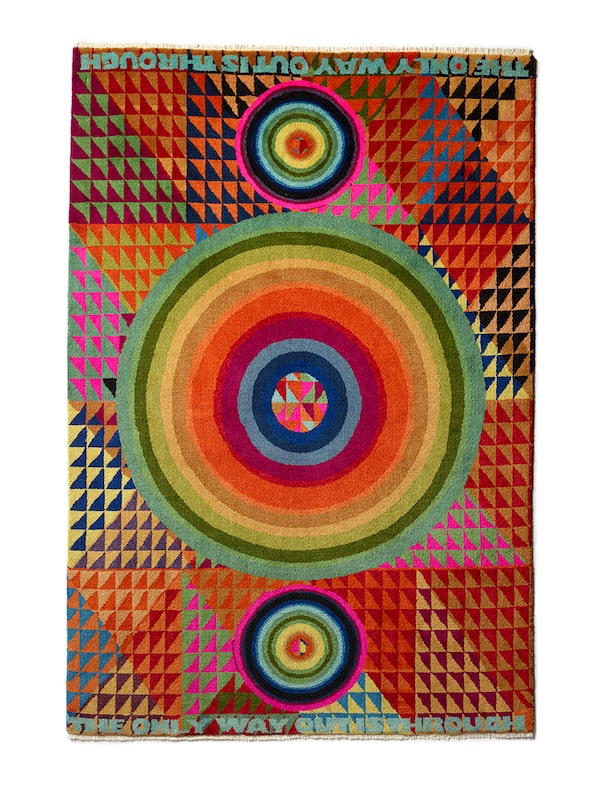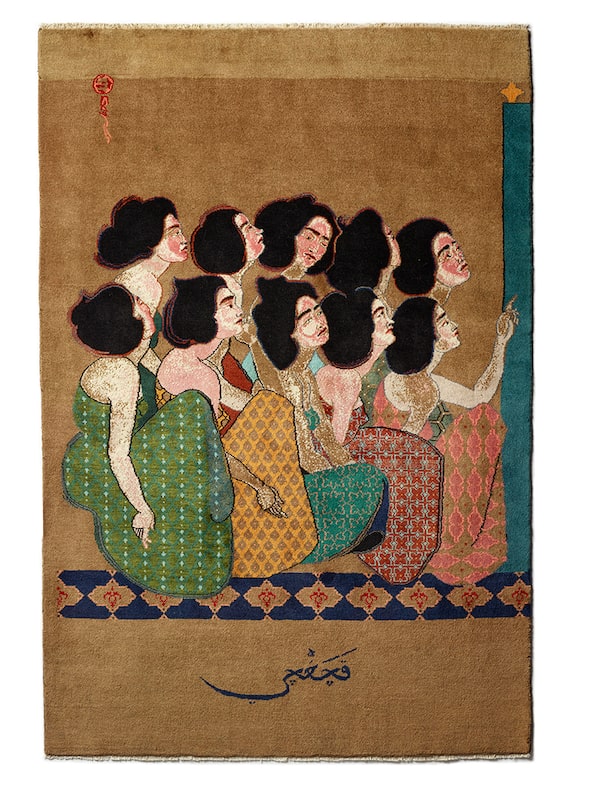
Jeffrey Gibson’s The Only Way Out Is Through is a wool rug being shown at Aga Khan Museum’s Sanctuary exhibit.ROBERT DIVERS HERRICK/AGA KHAN MUSEUM
The first thing you encounter when you visit Sanctuary, a thought-provoking exhibit now showing at the Aga Khan Museum in Toronto, are the words: “This is a sanctuary where we all belong.” Inspired by the FOR-SITE Foundation in California, a non - profit organization dedicated to art, the exhibit explores the notion of sanctuary and how to find it.
Thirty-six artists from 22 countries were invited to create designs that would be re-imagined on 4-foot by 6-foot wool rugs, reminiscent of Islamic prayer rugs. The artists' designs were sent to master weavers in Pakistan indicating what colours of yarn and what knots to use in weaving each rug.
“The results are these works of art that are spectacularly varied and reflective of the artists' personal stories, many of which include experiences as refugees and migrants,” says Michael Chagnon, the museum’s curator.

Hayv Kahraman’s Kachakchi rug is being shown at Aga Khan Museum.FOR-SITE FOUNDATION
Artist Tammam Azzam’s art studio became his safe haven away from the turmoil and violence during civil war in Syria. Unable to get art supplies, he used torn scraps of carpet to imagine and create until he and his family fled the country. Azzam and his paper collages, reminiscent of another time and place, are the basis for his untitled Sanctuary rug design.
Artist Hayv Kahraman’s design borrows imagery from her 2015 painting Kachachi, titled after an Iraqi term for “smuggler,” which is scrawled in Arabic script across the bottom of the piece. She describes the scene as a childhood memory of her family hiring a smuggler to help them flee from Iraq. The women gathered are quietly learning how to escape.
One of the exhibit’s more eye-popping designs is one by Indigenous artist Jeffrey Gibson, who is based in the United States. Gibson conflates life in the psychedelic 1960s and Indigenous principles in a remarkable display of colour. Text on the rug reads: “The only way out is through.”
Gibson’s design reflects a level of resolve in the aftermath of past cultural and political social movements.
Chagnon credits a smart and adventurous exhibit team with creating a multidimensional experience.

Tamman Azzam’s Untitled is being shown at Aga Khan Museum.FOR-SITE FOUNDATION
“With this exhibit, we’ve tried to tease out the idea of our Earth and our cosmos as our sanctuary. Almost every element of the exhibition is sustainable,” he says.
The Aga Khan team sourced recycled vinyl for labels. Toronto-based artist Joel Cottrill developed a unique calligraphic technique that he used to handpaint texts on the walls. In collaboration with scholar and artist Dr. Azra Aksamija, T-shirts donated by the local community were cut into strips and knotted together to create soaring walls in many colours hung from repurposed beams that evoke the structure of the loom mechanism used to weave rugs and textiles.
A visit to Sanctuary is one that wraps you in its arms with a sense of peace and tranquility. An original score of music called Sanctuaries by world-renowned rabab master Qais Essar adds to the experience.
“We had no idea this exhibit would be so relevant in 2020 with the onset of a global pandemic,” says Chagnon.
“Visitors share with us their sense of relief at being able to return to our serene space in downtown Toronto and experience a feeling of hope and optimism.”
Perhaps Sanctuary’s most powerful message is that art, in its many forms, can offer a way to safety and solace during troubled times.
Advertising feature produced by Globe Content Studio. The Globe’s editorial department was not involved.